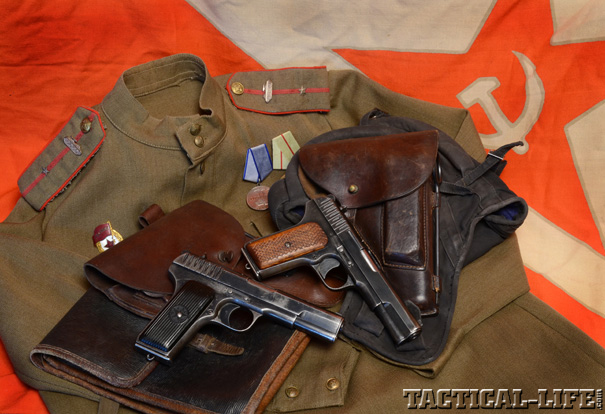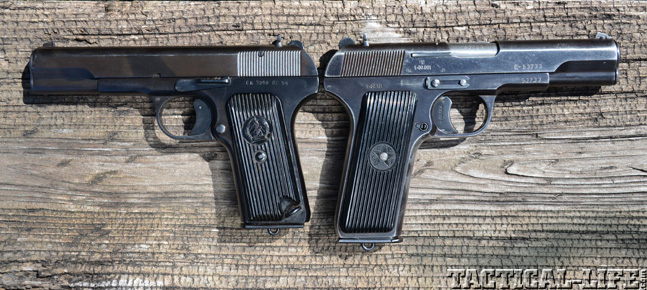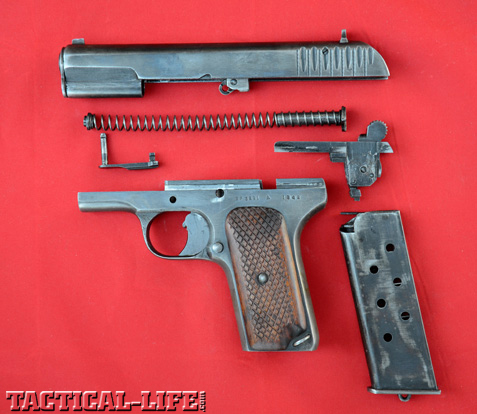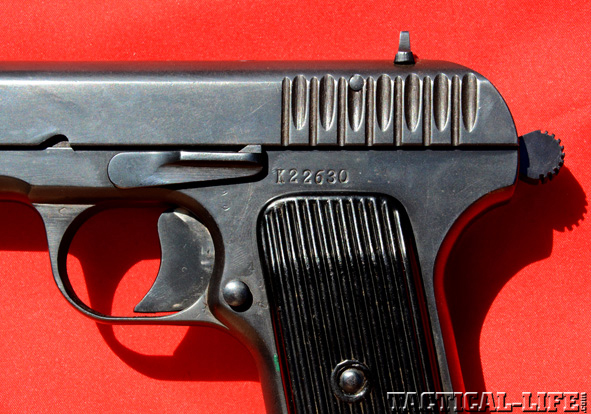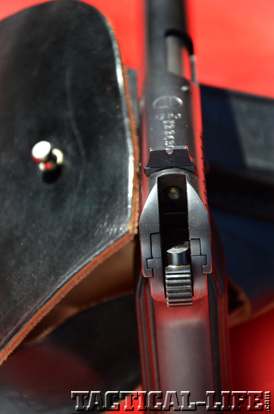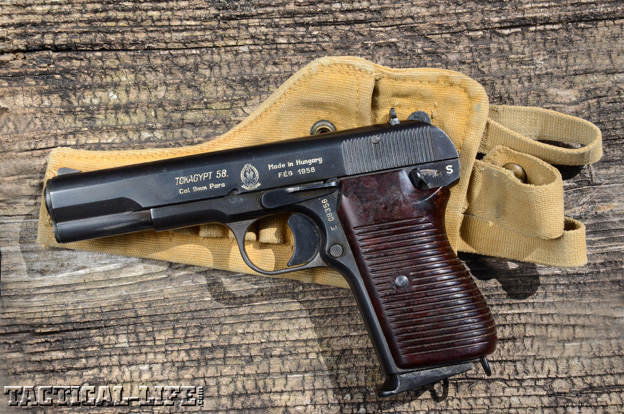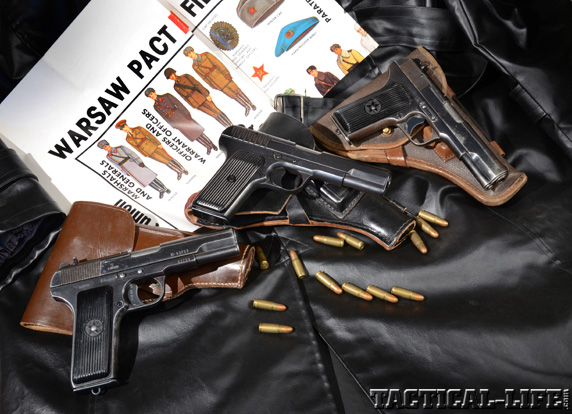As is the AK47 and its descendants, the Tokarev TT33 pistol is an excellent example of Soviet arms design, which emphasizes ease of production, simplicity of operation and durability. Prior to the adoption of the Tokarev, the primary Soviet-produced handgun was the Nagant M1895 revolver. Admittedly, the M1895 is memorable for the fact that, unlike numerous revolvers used in books and films, it can be suppressed—it has a cylinder that moves forward to seal against the forcing cone. But compared to the autoloading pistols used by other countries after World War I, the M1895 was fairly primitive. After the Russian Revolution, the Mauser M1896, especially the “Bolo” model named for its usage by the Bolsheviks, was widely employed. By the later 1920s, however, the Revolutionary Military Council was ready for a more modern autoloading pistol. A design by Fedor Tokarev was deemed worthy of production as a result of testing during late 1930. The Tokarev design owed a lot to the Colt-Browning locked-breech system—it kept the swinging link of the Colt 1911. The Tokarev also incorporated three other features that were deemed desirable by the Revolutionary Military Council. Two features simplified production: the elimination of feed lips from the magazine as they were machined into the pistol’s frame, and the elimination of a safety. The third feature eased maintenance: a hammer/lockwork assembly was installed that could be easily removed as a unit. This feature would later be included on the French M1935 and is still used on the SIG P210.
The Soviets liked the 7.63x25mm Mauser cartridge for its penetration and range. As a result, the Tokarev was designed to take a cartridge based on the Mauser round: the 7.62x25mm Tokarev round. In addition to Tokarev pistols, this round would also be used in the PPSh41 and PPS43 submachine guns.
Wheels of War
Initially, 1,000 Tokarev TT30 pistols were manufactured for troop trials in January 1931. As a result, some changes were made to facilitate their manufacture. One of the most noteworthy changes was replacing the twin locking lugs on the top surface of the barrel with two bands running around the circumference of the barrel. These still allowed for the secure locking necessary with the powerful 7.62x25mm cartridge but made machining of the barrel much faster. Although production of the TT30 continued while the improved version was being developed, the TT33 replaced it. The TT33 would remain in production at Tula Arsenal for one to two years after the adoption of the Makarov PM by the Soviet armed forces in 1951. The Tokarev still remained in Soviet service until the 1960s. Some of my Russian police contacts advised me that, about 20 years ago, though they were armed with Makarovs there were still TT33s and even M1895 revolvers in their armories.
Advertisement — Continue Reading Below
It is interesting that during WWII, the TT33 was very popular with the German troops who plundered it. They could fire 7.63x25mm Mauser ammunition in the TT33, and they found it offered excellent penetration through heavy Soviet winter clothing on the Western Front. As used in the German Army, it was designated the Pistole 615 (r) (”r” for Russian). In addition to being used by the Soviet armed forces, the TT33 was supplied to many Soviet surrogates and was produced on license by Soviet allies. At least 50 countries used the Tokarev, mostly in the former Warsaw Pact, Asia and Africa.
Among the countries producing their own version of the Tokarev were China (Type 54), Yugoslavia (M57), North Korea (Type 68), Romania (TTC), Hungary (M48), and Poland (PW wz.33). The Yugoslav M57 has a longer grip and a magazine that holds nine rounds instead of the standard TT33 magazine’s eight rounds. Hungary also produced the Tokagypt for Egypt, which was in 9x19mm caliber and had a thumb safety. Versions of the Tokarev are still in second-line service with some third-world armies and police, and it still turns up with various guerrilla/terrorist groups. I have seen reference to Pakistani-made Tokarevs, but these may be rough Darra-made examples. I would be very leery of firing a pistol chambered for the hot 7.62x25mm Tokarev round that had been produced using primitive, if any, heat treatment. Speaking of hot ammunition, bear in mind that some Czech 7.62x25mm rounds are loaded to very high pressure.
Hands On
I’ve fired versions of the Tokarev quite a bit. I used to do training for personnel who were going to be working in dangerous countries. For some of these courses, I would include weapons likely to be encountered, in use by local terrorists or guerillas. The Tokarev was one of the pistols I normally included, and it was one of the easiest to train personnel with since it lacked a safety. However, since one of the “non-victims” I was training would not know if the “Tok” had a round chambered or not, I always taught trainees to rack the slide as they brought the pistol into action. In the worst case, they ejected a round from the chamber but avoided the possibility of dropping the hammer on an empty chamber.
Advertisement — Continue Reading Below
Rarely, I have carried a Tokarev while working in some “faraway place with a strange-sounding name.” I did not carry the pistol with a round in the chamber as I did not trust carrying it in Condition Two—with the hammer down on a loaded chamber or on half cock, as the Soviets had apparently intended, though they actually carried it in Condition Three—with an empty chamber. Allow me to digress for a moment: You may see TT33-type Toks with a safety on the frame. These are normally Tokarevs manufactured to meet points for import into the U.S. Among collectors, these pistols are considered undesirable. The true Tokarev collector will strive to purchase an original Tokarev without the added safety. The Tokagypt is an exception since it was manufactured with a safety.
I like the Tokarev’s sights better than many other military pistols from the first half of the 20th century as the front sight is high enough and open enough for quick sight acquisition. I also like the fact that the TT33 uses a magazine-release button similar to that of the Colt 1911, rather than a bottom magazine release. Some Tokarevs such as the Russian TT33 have a lanyard ring on the grip as well as a lanyard ring on the base of the magazine. Given that a lot WWII combat on the Eastern Front was in the snow, a lanyard ring to keep magazines from getting lost makes sense.
Disadvantages of the Tokarev are that disassembly is a little difficult and that there are non-captive parts that can get lost. It is also necessary to slide a slide-stop retainer clip in order to remove the slide stop. With practice, the TT33 really isn’t any harder to strip than the Colt 1911, but the 1911 isn’t easy by current standards. Another disadvantage of the TT33 is its grip-to-slide angle as it does not lend itself to natural pointing.
Advertisement — Continue Reading Below
21st Century
I find the Tokarev one of the more interesting 20th-century military pistols. It was produced in large quantities and saw wide use during the Cold War. That makes it a very interesting collectable, especially for those my age who remember school nuclear-attack drills. Other than the times I carried a Tokarev of some ilk because it was the best weapon I had available, I would normally consider it more a collectible than a shooting gun, though I would enjoy taking it out to the range occasionally.
If you do decide to collect Tokarevs, do your best to find ones in good condition with matching numbers, and accessories if at all possible. Prices on nice Tokarevs have doubled over the last few years—originals will likely continue to grow in value. But if you just want a Tokarev for shooting cheap 7.62x25mm ammunition, then a basic sample in reasonable condition should definitely fit the bill.
